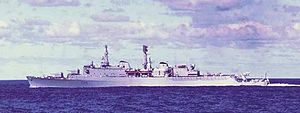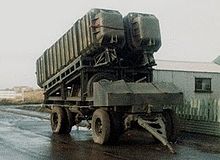- HMS Glamorgan (D19)
-

HMS GlamorganCareer (UK) 
Name: HMS Glamorgan Builder: Vickers-Armstrongs Laid down: 13 September 1962 Launched: 9 July 1964 Commissioned: 11 October 1966 Decommissioned: 1986 Motto: I Fyny Bo'r Nod
(Welsh: "I Give Way To None")Fate: Sold to Chile in September 1986 Career (Chile) 
Name: Almirante Latorre Acquired: September 1986 Commissioned: 1986 Decommissioned: 1998 Fate: Scrapped and sunk at sea on 11 April 2005 General characteristics Class and type: County class destroyer Displacement: 6,200 tonnes (6,100 long tons) (full load) Length: 520 ft (160 m) Beam: 53 ft (16 m) Draught: 20 ft 5 in (6.22 m) Propulsion: COSAG (Combined steam and gas), two sets of geared steam turbines producing 30,000 shp (22,000 kW), 2 shafts Speed: 30 knots (56 km/h) (maximum) Range: 4,000 nautical miles (7,400 km) at 28 knots (52 km/h) Capacity: 471 Armament: 2× Fore-mounted twin-gunned turret with 4.5 inch (114 mm) guns Mark N6 (Turret "B" was later replaced by 4× MM40 Exocet missile launchers)
2× mountings for Oerlikon 20 mm cannon
1× Aft-mounted Seaslug GWS.2 SAM (24 missiles)
2× mountings (port & starboard) for Seacat GWS-22 SAM (In Chilean service, the Seacat was replaced by 2× 8-cell VLS for Barak SAM)
2× triple-tube launchers for shipborne torpedoesAircraft carried: 1× Wessex HAS Mk 3 helicopter Aviation facilities: Flight deck and enclosed hangar for embarking one helicopter Falklands War campaignArgentine Invasion – South Georgia – Occupation – Paraquet – Black Buck – Belgrano – Sobral – Sheffield – Pebble Island – Mikado – Sutton – San Carlos – Ardent – Seal Cove – Antelope – Atlantic Conveyor – Coventry – Goose Green – Mount Kent – Top Malo House – Bluff Cove – Many Branch Point – Mount Harriet – Two Sisters – Glamorgan – Mount Longdon – Wireless Ridge – Mount Tumbledown – Port StanleyHMS Glamorgan was a County-class destroyer of the Royal Navy with a displacement of 5,440 tonnes. The ship was built by Vickers-Armstrongs in Newcastle Upon Tyne and named after the Welsh county of Glamorgan. She was launched on 9 July 1964, and was delivered to the Navy two years later.[1] From 1977 to 1979, she was the subject of a major refit,[2] when 'B' turret was replaced by four Exocet launchers.[3] In the spring and early summer of 1982 Glamorgan was involved in the Falklands War. In the last days of the war, Argentine navy technicians fired a land-based MM-38 Exocet missile after the ship strayed too close to shore. The ship was badly damaged, and 13 sailors on board were killed. She was refitted in late 1982. Her last active deployment for the Royal Navy was to the coast of Lebanon in 1984.
In 1986, she was sold to the Chilean Navy, and renamed Almirante Latorre. She served for 12 years until late 1998. On 11 April 2005, she sank while under tow to be broken up.
Contents
Falklands campaign
At the start of the Falklands campaign, on 2 April 1982, Glamorgan was already at sea off Gibraltar about to take part in exercises;[4] she was immediately diverted to join the main Royal Navy task force, and served as flagship for Admiral Sandy Woodward during the voyage south until 15 April, when he transferred his flag to HMS Hermes.[5] Her most useful armament proved to be her remaining twin 4.5-inch (114 mm) guns, which were used primarily to shell enemy positions on shore.
Glamorgan was first in action on the evening and night of 1 May when she joined forces with HMS Arrow and HMS Alacrity to bombard Argentine positions around Stanley. The three British ships soon came under attack by three IAI Dagger jets; two 500 lb bombs fell close alongside Glamorgan, causing minor underwater damage.[6]
Two weeks later on 14 May she was again in action, this time supporting British special forces on Pebble Island in the west of the Falklands,[7] and for the next two weeks until the end of May she was almost continuously engaged bombarding various shore positions on the east of the islands mainly as part of a plan to distract attention from the landings at San Carlos Water, but also against the airfield at Stanley and in support of British forces ashore. She also fired a Sea slug missile at the airstrip.[8]
At the beginning of June, the task force having been reinforced with other ships, Glamorgan was detached to protect shipping in the Towing, Repair and Logistics Area (TRALA), some 200 miles (320 km) away from the islands,[9] but as the campaign reached a climax she was recalled in the evening of 11 June to support the Royal Marines fighting the Battle of Two Sisters.[10]
At 06:37 the following morning, Saturday 12 June 1982, Glamorgan was attacked with an MM38 Exocet missile which was fired from an improvised shore-based launcher. The launcher was dubbed ITB (Instalación de Tiro Berreta) by the Argentine personnel, which approximately means in Argentine slang "trashy firing platform".[11] Two MM38 Exocet missiles, their launcher, transporter, and the associated electronics trailer were assembled by the Argentine navy at Puerto Belgrano and flown by a C-130 Hercules transport aircraft to the Falkland Islands. A RASIT radar supplied by the Argentinian Army tracked Glamorgan's movements. The two MM38 Exocet missiles had been removed from the destroyer ARA Seguí[12] and secured on the launcher. Glamorgan was steaming at about 20 knots (37 km/h) some 18 nautical miles (33 km) off shore. The first attempt to fire a missile failed. A second attempt was successful and a missile was launched, but it failed to find the target. The third attempt was more successful. The incoming Exocet missile was being tracked on both the bridge and operations room radar by the Principal Warfare Officer and Navigation Officer. Before the missile impact, the ship was moving at high speed. After the ship executed a rapid turn away from the missile in the limited time available, a few seconds, the Exocet struck the port side adjacent to the hangar near the stern. The turn had prevented the missile from striking the ship's side perpendicularly and penetrating; instead it hit the deck coaming at an angle, near the port Seacat launcher, skidded on the deck, and exploded. This made a 10ft by 15ft hole in the hangar deck and a 5ft by 4ft hole in the galley area below, where a fire started. The blast travelled forwards and down, and the missile body, still travelling forwards, penetrated the hangar door, causing a fully fuelled and armed Wessex helicopter to explode and start a severe fire in the hangar. Thirteen crew members were killed and more wounded. The ship was under way again with all fires extinguished by 10:00.[13]
On the following day, repairs were made at sea and, after the Argentinian surrender on 14 June, more extensive repairs were undertaken in the sheltered bay of San Carlos Water.[14] She sailed for home on 21 June, and re-entered Portsmouth on 10 July 1982 after 104 days at sea.[4]
Crew killed in the Falklands War
The following crew members were killed in action during the Falklands War.[15]
- Petty Officer Michael J. Adcock
- Cook Brian Easton
- Air Engineering Mechanic Mark Henderson
- Air Engineering Mechanic Brian P. Hinge
- Acting Chief Air Engineering Mechanic David Lee
- Cook Brian J. Malcolm
- Air Engineering Artificer Kelvin I. McCallum
- Marine Engineering Mechanic Terence W. Perkins
- Leading Cook Mark A. Sambles
- Leading Cook Anthony E. Sillence
- Steward John D. Stroud
- Lieutenant David H. R. Tinker
- Petty Officer Colin P. Vickers
After the Falklands campaign
HMS Glamorgan spent many months in late 1982 being refitted, and was back at sea in 1983. Her last active deployment for the Royal Navy was to the coast of Lebanon, assisting British peace-keeping troops there in 1984.[16]
She was decommissioned by the Royal Navy in 1986, sold to the Chilean Navy, and renamed Almirante Latorre. In 1996, Sea Cat was replaced with the Barak SAM. She served for 12 years until she was decommissioned again in late 1998. On 11 April 2005, she sank while under tow to be broken up.[17][18]
A Memorial was erected in 2011 in memory of the ship and the lost crew at Hookers Point outside Stanley[19].
See also
- List of ship launches in 1964
- List of ship commissionings in 1966
- List of ship decommissionings in 1986
- List of ship commissionings in 1986
- List of ship decommissionings in 1998
References
- Notes
- ^ HMS Glamorgan, the first two years
- ^ Author: Cooke, Anthony (1992). Emigrant ships: the vessels which carried migrants across the world, 1946-1972. Carmania Press, p. 32. ISBN 0951865609
- ^ Fitzsimmons, Bernard (1978). The Illustrated encyclopedia of 20th century weapons and warfare, Volume 7. Columbia House, p. 749
- ^ a b HMS Glamorgan: Diary of Events
- ^ Brown, David (1987). The Royal Navy and the Falklands War. Naval Institute Press, p. 87. ISBN 0870215728
- ^ Tinker, p. 191
- ^ Raid on Pebble Island
- ^ Tinker, p. 206
- ^ Tinker, p. 209
- ^ Scales, Robert H. (1990). Firepower in Limited War. Diane Publishing, pp. 221-223. ISBN 0788112287
- ^ (Spanish) Argentine video
- ^ Scheina, Robert L. (2003). Latin America's Wars: The age of the professional soldier, 1900-2001. Brassey's, p. 316. ISBN 1574884522
- ^ Inskip, Ian (2002). Ordeal by Exocet: HMS Glamorgan and the Falklands War, 1982. Chatham, p. 160-185. ISBN 186176197X
- ^ Villar, Roger (1984). Merchant ships at war: the Falklands experience. Naval Institute Press, p. 65. ISBN 087021845X
- ^ Tinker, p. 212
- ^ Lebanon 1982-84 From "Britain small wars" site]
- ^ MoD release detailing date and position of sinking, 25 July 2008
- ^ Colledge, J.J. and Warlow, Ben (2010). Ships of the Royal Navy: The Complete Record of All Fighting Ships of the Royal Navy. Casemate Publishers, p. 161. ISBN 1935149075
- ^ Navy News (02 March 2011). "Falklands 'forgotten ship' finally honoured". http://www.navynews.co.uk/news/1093-falklands-forgotten-ship-finally-honoured.aspx. Retrieved 27 March 2011.
- Bibliography
- Tinker, Lieut. David, R.N. (1982). A Message from the Falklands, The Life and Gallant Death of David Tinker, Lieut. R.N. from his Letters and Poems. Penguin. ISBN 0-14-006778-7.
- Woodward, Sandy; Robinson, Patrick (1992). One Hundred Days: Memoirs of the Falklands Battle Group Commander. HarperCollins. ISBN 0-00-215723-3.
- Inskip, Ian (2002). Ordeal by Exocet: HMS Glamorgan and the Falklands War. Chatham. ISBN 3186176197X.
- (Spanish) Interview to Rear Admiral (Engineer) Julio Pérez team leader of ITB Exocet battery
External links
- Extract about the Exocet attack on Glamorgan from Sandy Woodward's book (see above)
- Falklands timeline for Glamorgan
- Navy news account of Glamorgan in the Falklands (part 1) (part 2)
Coordinates: 35°58′0″S 77°22′0″W / 35.966667°S 77.366667°W
 Royal Navy
Royal Navy Chilean Navy
Chilean NavyAlmirante Cochrane · Almirante Latorre · Blanco Encalada · Capitán Prat
 Pakistan Navy
Pakistan NavyPreceded by: Daring class · Followed by: Type 82
List of destroyer classes of the Royal NavyCategories:- County class destroyers of the Royal Navy
- Tyne-built ships
- 1964 ships
- Ships damaged by aircraft
- Cold War destroyers of the United Kingdom
- Falklands War naval ships of the United Kingdom
- Royal Navy ship names
- County class destroyers of the Chilean Navy
- Maritime incidents in 1982
- Maritime incidents in 2005
- Shipwrecks in the Chilean Sea
Wikimedia Foundation. 2010.

